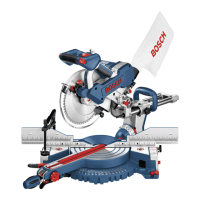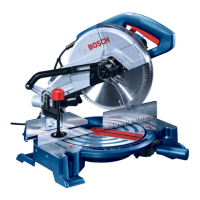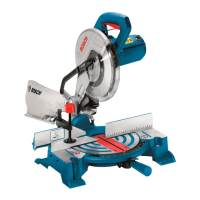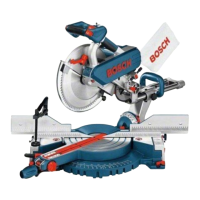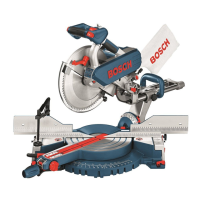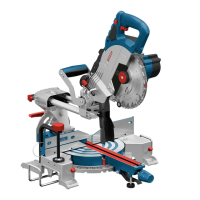English–91 609 929 F69 • (04.10) PS
Stationary or Flexible Mounting
To ensure safe handling, the electrotool
must be mounted on a flat and stabile
working surface (e.g., workbench).
If the electrotool is not mounted in this
manner, it could tip over.
Stationary Mounting
(see Figure )
Attach the electro#tool with suitable screw fasteners to
the working surface. The holes 17 serve for this pur#
pose.
Flexible Mounting
(see Figure
)
Clamp the electro#tool with commercially available
screw clamps by the feet to the working surface.
Mounting the Locking Knob
(see Figure
)
Screw the locking knob 12 into the hole above the le#
ver 13.
Do not tighten the knob too firmly.
5 OPERATING INSTRUCTIONS
Transport Safety
(see Figure
)
Before all work on the machine, pull the mains
plug.
The transport locking pin 26 makes possible easy han#
dling of the machine when transporting to the various
working locations.
Securing the Machine (Transport Position)
Tighten the locking screw 29 for the securing the slide
rails 23.
Pull the transport locking pin 26 completely out and
turn by 90°. Allow the transport locking pin to engage
in this position.
Press the locking lever 41 (also see Figure ) and at
the same time swing the tool arm by the handle 5
downward until the transport locking pin latches in the
end position.
Releasing the Machine (Working Position)
Press the tool arm with the handle 5 downward some#
what to relieve the load on the transport locking pin.
Pull the transport locking pin 26 completely out and
turn by 90°. Allow the transport locking pin to engage
in this position.
Guide the tool arm slowly upward.
Changing the Tool
Before all work on the machine, pull the mains
plug.
Use only sharp, flawless saw blades. Change
cracked, bent or dull saw blades without delay.
Use only saw blades that comply with the characteris#
tic data given in these operating instructions and have
been tested according to EN 847#1 and appropriately
marked.
Use only saw blades whose allowable rotational speed
is as least as high as the no#load speed of the electro#
tool.
Actuate the spindle lock only when the saw blade is at
a standstill.
The saw blade becomes very hot while working; do
not take hold of it until it has cooled.
Wear protective gloves to avoid injury from the sharp
cutting edges of the saw blade during changing the
saw blade.
Removing the Saw Blade
Place the machine in the working position.
Pull the transport locking pin 26 completely out and
turn by 90°. Allow the transport locking pin to engage
in this position.
The tool arm is then locked in the working position.
Loosen the screw 48 with the Phillips screwdriver 33
provided. Do not unscrew the screw completely. Un#
screw the screw 49 with the same Philips screwdriver.
(see Figure )
Press the locking lever 41 (also see Figure ) and
swing the swinging guard 8 to the rear to the stop.
Turn the hex#head bolt 50 with the hex#socket span#
ner 33 (14 mm) provided while at the same time press#
ing the spindle lock 40 until it engages.
(see Figure
)
Hold the spindle lock 40 depressed and screw out the
hex#head bolt 50 in the clockwise direction (lefthand
threads!). Remove the washer 51 and the clamping
flange 52. Remove the saw blade. (see Figure
)
A1
A2
B
C
N
D1
N
D2
D3
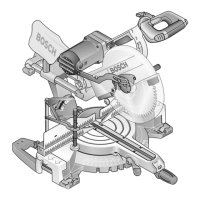
